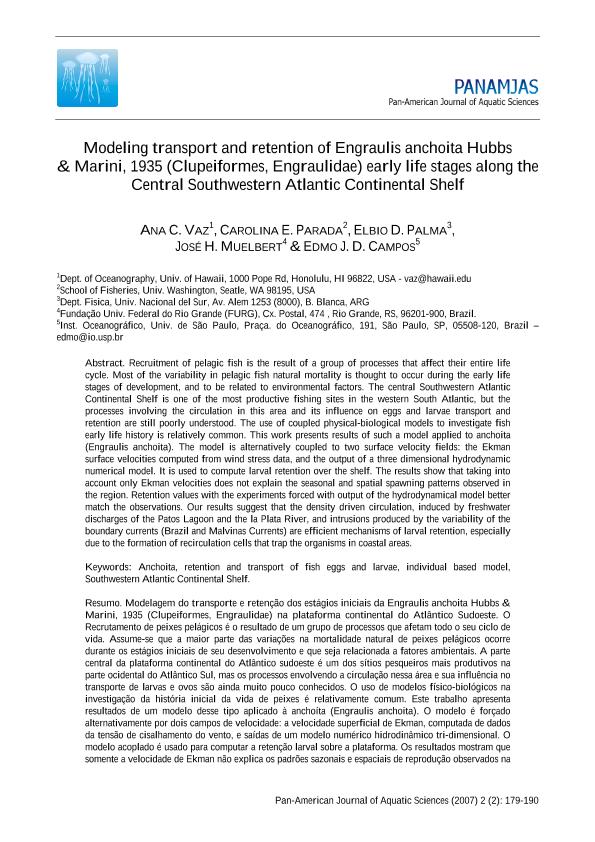Mostrar el registro sencillo del ítem
dc.contributor.author
Vaz, Ana C.
dc.contributor.author
Parada, Carolina E.
dc.contributor.author
Palma, Elbio Daniel

dc.contributor.author
Muelbert, José H.
dc.contributor.author
Campos, Edmo

dc.date.available
2017-06-09T19:54:05Z
dc.date.issued
2007-12
dc.identifier.citation
Vaz, Ana C.; Parada, Carolina E.; Palma, Elbio Daniel; Muelbert, José H.; Campos, Edmo; Modeling transport and retention of Engraulis anchoita Hubbs & Marini, 1935 (Clupeiformes, Engraulidae) early life stages along the Central Southwestern Atlantic Continental Shelf; Panamjas; Pan-American Journal of Aquatic Sciences; 2; 2; 12-2007; 179-190
dc.identifier.issn
1809-9009
dc.identifier.uri
http://hdl.handle.net/11336/17917
dc.description.abstract
Recruitment of pelagic fish is the result of a group of processes that affect their entire life cycle. Most of the variability in pelagic fish natural mortality is thought to occur during the early life stages of development, and to be related to environmental factors. The central Southwestern Atlantic Continental Shelf is one of the most productive fishing sites in the western South Atlantic, but the processes involving the circulation in this area and its influence on eggs and larvae transport and retention are still poorly understood. The use of coupled physical-biological models to investigate fish early life history is relatively common. This work presents results of such a model applied to anchoita (Engraulis anchoita). The model is alternatively coupled to two surface velocity fields: the Ekman surface velocities computed from wind stress data, and the output of a three dimensional hydrodynamic numerical model. It is used to compute larval retention over the shelf. The results show that taking into account only Ekman velocities does not explain the seasonal and spatial spawning patterns observed in the region. Retention values with the experiments forced with output of the hydrodynamical model better match the observations. Our results suggest that the density driven circulation, induced by freshwater discharges of the Patos Lagoon and the la Plata River, and intrusions produced by the variability of the boundary currents (Brazil and Malvinas Currents) are efficient mechanisms of larval retention, especially due to the formation of recirculation cells that trap the organisms in coastal areas.
dc.description.abstract
Recrutamento de peixes pelágicos é o resultado de um grupo de processos que afetam todo o seu ciclo de vida. Assume-se que a maior parte das variações na mortalidade natural de peixes pelágicos ocorre durante os estágios iniciais de seu desenvolvimento e que seja relacionada a fatores ambientais. A parte central da plataforma continental do Atlântico sudoeste é um dos sítios pesqueiros mais produtivos na parte ocidental do Atlântico Sul, mas os processos envolvendo a circulação nessa área e sua influência no transporte de larvas e ovos são ainda muito pouco conhecidos. O uso de modelos físico-biológicos na investigação da história inicial da vida de peixes é relativamente comum. Este trabalho apresenta resultados de um modelo desse tipo aplicado à anchoíta (Engraulis anchoita). O modelo é forçado alternativamente por dois campos de velocidade: a velocidade superficial de Ekman, computada de dados da tensão de cisalhamento do vento, e saídas de um modelo numérico hidrodinâmico tri-dimensional. O modelo acoplado é usado para computar a retenção larval sobre a plataforma. Os resultados mostram que somente a velocidade de Ekman não explica os padrões sazonais e espaciais de reprodução observados na região. Valores de retenção obtidos com o modelo forçado com saídas do modelo hidrodinâmico são comparados aos observados. Os resultados sugerem também que a circulação gerada por gradientes de densidade resultantes das descargas de água doce do Rio da Prata e da Lagoa dos Patos, e as intrusões de águas das correntes de contorno oeste (Brasil e Malvinas), são mecanismos eficientes de retenção larval, especialmente devido à formação de células de recirculação que aprisionam os organismos em áreas costeiras.
dc.format
application/pdf
dc.language.iso
por
dc.publisher
Panamjas
dc.rights
info:eu-repo/semantics/openAccess
dc.rights.uri
https://creativecommons.org/licenses/by-nc-sa/2.5/ar/
dc.subject.classification
Oceanografía, Hidrología, Recursos Hídricos

dc.subject.classification
Ciencias de la Tierra y relacionadas con el Medio Ambiente

dc.subject.classification
CIENCIAS NATURALES Y EXACTAS

dc.title
Modeling transport and retention of Engraulis anchoita Hubbs & Marini, 1935 (Clupeiformes, Engraulidae) early life stages along the Central Southwestern Atlantic Continental Shelf
dc.title
Modelagem do transporte e retenção dos estágios iniciais da Engraulis anchoita Hubbs & Marini, 1935 (Clupeiformes, Engraulidae) na plataforma continental do Atlântico Sudoeste.
dc.type
info:eu-repo/semantics/article
dc.type
info:ar-repo/semantics/artículo
dc.type
info:eu-repo/semantics/publishedVersion
dc.date.updated
2017-05-17T13:48:45Z
dc.journal.volume
2
dc.journal.number
2
dc.journal.pagination
179-190
dc.journal.pais
Brasil

dc.journal.ciudad
Río de Janeiro
dc.description.fil
Fil: Vaz, Ana C.. University Of Hawaii At Manoa; Estados Unidos
dc.description.fil
Fil: Parada, Carolina E.. University of Washington; Estados Unidos
dc.description.fil
Fil: Palma, Elbio Daniel. Consejo Nacional de Investigaciones Científicas y Técnicas. Centro Científico Tecnológico Conicet - Bahía Blanca. Instituto Argentino de Oceanografía. Universidad Nacional del Sur. Instituto Argentino de Oceanografía; Argentina
dc.description.fil
Fil: Muelbert, José H.. Fundação Universidade Federal do Rio Grande; Brasil
dc.description.fil
Fil: Campos, Edmo. University of São Paulo; Brasil
dc.journal.title
Pan-American Journal of Aquatic Sciences
dc.relation.alternativeid
info:eu-repo/semantics/altIdentifier/url/http://www.panamjas.org/pdf_artigos/PANAMJAS_2(2)_179-190.pdf
Archivos asociados
